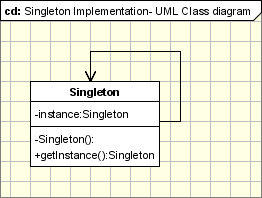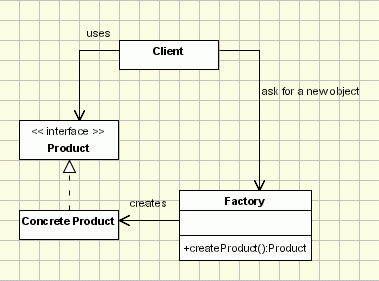 Java
Java
 javaTutorial
javaTutorial
 A brief analysis of the singleton pattern and simple factory pattern in Java design pattern programming
A brief analysis of the singleton pattern and simple factory pattern in Java design pattern programming
A brief analysis of the singleton pattern and simple factory pattern in Java design pattern programming
Singleton Pattern
Motivation
Sometimes it is important to have only one instance of a class. For example, a system should have only one instance of window management.
The singleton pattern is the simplest design pattern: a class is responsible for instantiating itself, ensuring that there is only one instance, and providing an entrance to access this instance.
Purpose
1. Ensure that only one instance is created.
2. Provide access to this instance.

Use final to ensure it is created once, and private constructor to ensure not to be instantiated. The public getInstance method ensures external access. The following is the hungry mode:
public class Singleton {
private static final Singleton instance = new Singleton();
private Singleton() {}
public static Singleton getInstance() {
return instance;
}
}
The lazy mode:
public class SingletonDemo {
private static volatile SingletonDemo instance = null;
private SingletonDemo() { }
public static SingletonDemo getInstance() {
if (instance == null) {
synchronized (SingletonDemo .class){
if (instance == null) {
instance = new SingletonDemo ();
}
}
}
return instance;
}
}
Applicable scenarios and examples
1. Logger class, which prevents a Logger instance from being created every time the log is printed.
2. Control class, generally there is only one control instance in the entire system.
Specific issues and implementation
1. Thread safety, a robust singleton pattern should be thread safe.
2. Lazy mode uses a double lock mechanism.
3. Hungry mode uses static variables, which are instantiated when the program is loaded, ensuring that there is only one instance.
4. Abstract factories and factory methods are usually designed in singleton mode to ensure that there is only one factory.
5. When using serialization and deserialization, multiple instances will be created. Use the readResolve function to avoid this situation, but it is best not to use serialization.
public class Singleton implements Serializable {
...
// This method is called immediately after an object of this class is deserialized.
// This method returns the singleton instance.
protected Object readResolve() {
return getInstance();
}
}
Key points
1. In multi-threaded programs, pay attention to data synchronization.
2. Use the readResolve method to return an instance when serializing to avoid multiple objects being created.
3. If loaded by multiple class loaders, multiple instances will be created.
Simple Factory Pattern
Motivation
Simple Factory Pattern is the basis and preliminary implementation of abstract factory and factory method.
Purpose
1. Do not disclose object instantiation details to clients.
2. Create objects through common interfaces.
Implementation

The implementation is very simple:
1. When the Client needs a Product, it does not use new to create it, but provides the Product description to the Factory and lets the Factory provide a new Product.
2. Factory instantiates a Product to the Client.
3. Client uses abstract Product and does not care about the specific implementation of Product.
Example
1. Drawing program for drawing shapes. The shape is the Product interface, and the triangle is the Concrete Product. We can create a factory and then create the corresponding product according to the customer's description. But when adding new shapes, we need to modify the factory class.
Specific issues and implementation
1. When adding new products, the factory needs to be modified.
public class ProductFactory{
public Product createProduct(String ProductID){
if (id==ID1)
return new OneProduct();
if (id==ID2)
return new AnotherProduct();
... // so on for the other Ids
return null; //if the id doesn't have any of the expected values
}
...
}
Generally we judge product descriptions through if statements and instantiate different products. When there are new products, we need to add new judgments. This problem can be solved through the abstract factory pattern.
Summary
1. Use the factory pattern only when you really need it, otherwise it will only increase the complexity of the program. For example, when multiple objects have similar basic types, you can consider using the simple factory pattern to create objects uniformly.
2. Simple factory has a lot of judgment branch statements, which violates the open-close principle of closing modifications. Therefore, it is wise to use the simple factory mode for some fixed and simple programs, and to use the simple factory mode for some complex programs that require frequent expansion. Programs use abstract factory pattern or factory method pattern.
For more articles on the singleton pattern and simple factory pattern in Java design pattern programming, please pay attention to the PHP Chinese website!

Hot AI Tools

Undresser.AI Undress
AI-powered app for creating realistic nude photos

AI Clothes Remover
Online AI tool for removing clothes from photos.

Undress AI Tool
Undress images for free

Clothoff.io
AI clothes remover

Video Face Swap
Swap faces in any video effortlessly with our completely free AI face swap tool!

Hot Article

Hot Tools

Notepad++7.3.1
Easy-to-use and free code editor

SublimeText3 Chinese version
Chinese version, very easy to use

Zend Studio 13.0.1
Powerful PHP integrated development environment

Dreamweaver CS6
Visual web development tools

SublimeText3 Mac version
God-level code editing software (SublimeText3)

Hot Topics
 1393
1393
 52
52
 1205
1205
 24
24
 Is the company's security software causing the application to fail to run? How to troubleshoot and solve it?
Apr 19, 2025 pm 04:51 PM
Is the company's security software causing the application to fail to run? How to troubleshoot and solve it?
Apr 19, 2025 pm 04:51 PM
Troubleshooting and solutions to the company's security software that causes some applications to not function properly. Many companies will deploy security software in order to ensure internal network security. ...
 How to simplify field mapping issues in system docking using MapStruct?
Apr 19, 2025 pm 06:21 PM
How to simplify field mapping issues in system docking using MapStruct?
Apr 19, 2025 pm 06:21 PM
Field mapping processing in system docking often encounters a difficult problem when performing system docking: how to effectively map the interface fields of system A...
 How to elegantly obtain entity class variable names to build database query conditions?
Apr 19, 2025 pm 11:42 PM
How to elegantly obtain entity class variable names to build database query conditions?
Apr 19, 2025 pm 11:42 PM
When using MyBatis-Plus or other ORM frameworks for database operations, it is often necessary to construct query conditions based on the attribute name of the entity class. If you manually every time...
 How does IntelliJ IDEA identify the port number of a Spring Boot project without outputting a log?
Apr 19, 2025 pm 11:45 PM
How does IntelliJ IDEA identify the port number of a Spring Boot project without outputting a log?
Apr 19, 2025 pm 11:45 PM
Start Spring using IntelliJIDEAUltimate version...
 How do I convert names to numbers to implement sorting and maintain consistency in groups?
Apr 19, 2025 pm 11:30 PM
How do I convert names to numbers to implement sorting and maintain consistency in groups?
Apr 19, 2025 pm 11:30 PM
Solutions to convert names to numbers to implement sorting In many application scenarios, users may need to sort in groups, especially in one...
 How to safely convert Java objects to arrays?
Apr 19, 2025 pm 11:33 PM
How to safely convert Java objects to arrays?
Apr 19, 2025 pm 11:33 PM
Conversion of Java Objects and Arrays: In-depth discussion of the risks and correct methods of cast type conversion Many Java beginners will encounter the conversion of an object into an array...
 How to use the Redis cache solution to efficiently realize the requirements of product ranking list?
Apr 19, 2025 pm 11:36 PM
How to use the Redis cache solution to efficiently realize the requirements of product ranking list?
Apr 19, 2025 pm 11:36 PM
How does the Redis caching solution realize the requirements of product ranking list? During the development process, we often need to deal with the requirements of rankings, such as displaying a...
 How to convert names to numbers to implement sorting within groups?
Apr 19, 2025 pm 01:57 PM
How to convert names to numbers to implement sorting within groups?
Apr 19, 2025 pm 01:57 PM
How to convert names to numbers to implement sorting within groups? When sorting users in groups, it is often necessary to convert the user's name into numbers so that it can be different...



